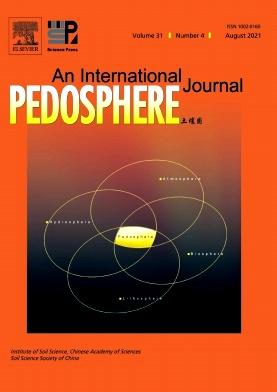Bacterial community characteristics in epigeic and anecic earthworm vermicompartments within soil-earthworm systems
IF 5.2
2区 农林科学
Q1 SOIL SCIENCE
引用次数: 0
Abstract
Earthworms are crucial to soil ecosystems as keystone species. They perform various ecological functions through their associated microbiomes. However, the characteristics of these microbiomes in various vermicompartments (earthworm-associated compartments) within soil-earthworm systems have not been systematically studied. Here, using earthworms of two ecotypes (i.e., epigeic Eisenia fetida and anecic Metaphire guillelmi) as models, we conducted a full and comprehensive exploration of the bacterial community in several potential distinct compartments, including bulk soil, drilosphere, gut wall, gut content, and casts, through 2D-terraria incubation technology and high-throughput sequencing approaches. Bacterial diversity, community structures in each compartment, differential OTUs in vermicompartments compared with bulk soil, and the co-occurrence relationship of bacteria in bulk soil and gut-compartments (i.e., gut wall and gut content) were assessed. Results showed that three major vermicompartments, i.e., drilosphere, gut, and casts, were distinctly different in hosting the bacterial community. The levels of alpha diversity followed the order of drilosphere > casts > gut wall ≈ gut content. These patterns of vermicompartments along earthworms did not vary with ecotype, implying that the vermicompartments were the primary factors influencing the bacterial community. Finally, based on the difference in microbiomes in gut-compartments and the state-of-the-art use of the term “gut microbiomes”, it is recommended to establish a unified definition of gut microbes that encompasses microbiomes residing in both the gut wall and gut content, which could provide a clear and consistent understanding of gut microbiomes. This work provides a comprehensive overview of earthworm-associated microbiomes, enhancing our understanding of fundamental earthworm ecology and soil biology.
土壤-蚯蚓系统中附生和异生蚯蚓蚓室细菌群落特征
蚯蚓是土壤生态系统的关键物种。它们通过其相关的微生物群执行各种生态功能。然而,土壤-蚯蚓系统中不同蚓室(蚯蚓相关室)中这些微生物组的特征尚未得到系统的研究。本研究以两种生态型蚯蚓(即外生型费提达Eisenia fetida和内生型半生型guillelmi)为模型,通过2D-terraria孵育技术和高通量测序方法,对几个潜在的不同区室的细菌群落进行了全面而全面的探索,包括散装土壤、岩石圈、肠壁、肠道内容物和粪便。评估了细菌多样性、各隔室的群落结构、蚯蚓隔室与散装土壤的OTUs差异,以及散装土壤中细菌与肠道隔室(即肠壁和肠道内容物)的共生关系。结果表明,三种主要的蚓腔,即钻圈、肠道和铸体,在承载细菌群落方面存在明显差异。α多样性水平依次为:钻孔圈>;投在肠壁≈肠道含量。蚯蚓微室的分布模式不随生态类型的变化而变化,表明蚯蚓微室是影响细菌群落的主要因素。最后,基于肠道微生物组的差异和“肠道微生物组”一词的最新使用,建议建立一个统一的肠道微生物定义,包括存在于肠壁和肠道内容物中的微生物组,这可以提供对肠道微生物组的清晰和一致的理解。这项工作提供了蚯蚓相关微生物组的全面概述,增强了我们对蚯蚓生态学和土壤生物学基础的理解。
本文章由计算机程序翻译,如有差异,请以英文原文为准。
求助全文
约1分钟内获得全文
求助全文
来源期刊

Pedosphere
环境科学-土壤科学
CiteScore
11.70
自引率
1.80%
发文量
147
审稿时长
5.0 months
期刊介绍:
PEDOSPHERE—a peer-reviewed international journal published bimonthly in English—welcomes submissions from scientists around the world under a broad scope of topics relevant to timely, high quality original research findings, especially up-to-date achievements and advances in the entire field of soil science studies dealing with environmental science, ecology, agriculture, bioscience, geoscience, forestry, etc. It publishes mainly original research articles as well as some reviews, mini reviews, short communications and special issues.
 求助内容:
求助内容: 应助结果提醒方式:
应助结果提醒方式:


